As time ticks on and football restarts, one may find himself perplexed when remembering that one of the game’s best coaches is still unemployed.
Mauricio Pochettino has had time to sit back and relax since his dismissal from Tottenham Hotspur in November of last year and he is undoubtedly one of this summer’s most sought-after targets in club football.
His highest highs at Tottenham were memorable, and his lowest lows were substandard.
This Mauricio Pochettino tactical analysis aims to understand why and how his tenure at Spurs ended the way it did.
Throughout the analysis, we will observe Mauricio Pochettino’s Spurs, the system that made them such a consistent outfit, and of course the fall that led to his sacking.
With this tactical analysis, we aim to answer the larger question: Wherever Pochettino ends up, what will his next team look like on the pitch?
Mauricio Pochettino Pressing
A fixture of every good Pochettino team even before his time at Tottenham Hotspur was the pressing intensity he instilled into his sides.
In their peak, Spurs usually ranked only second to Pep Guardiola’s Manchester City in PPDA (passes per defensive action) with a very low 7.7 passes allowed.
Tottenham’s most effective press was when they were in their 3-4-2-1 shape that allowed more flexibility in the attacking half of the pitch but also enabled more men to come back to defend.
Tottenham used this system of press and cover to nullify a strong Chelsea team’s midfield presence in the 2016/17 FA Cup Final.
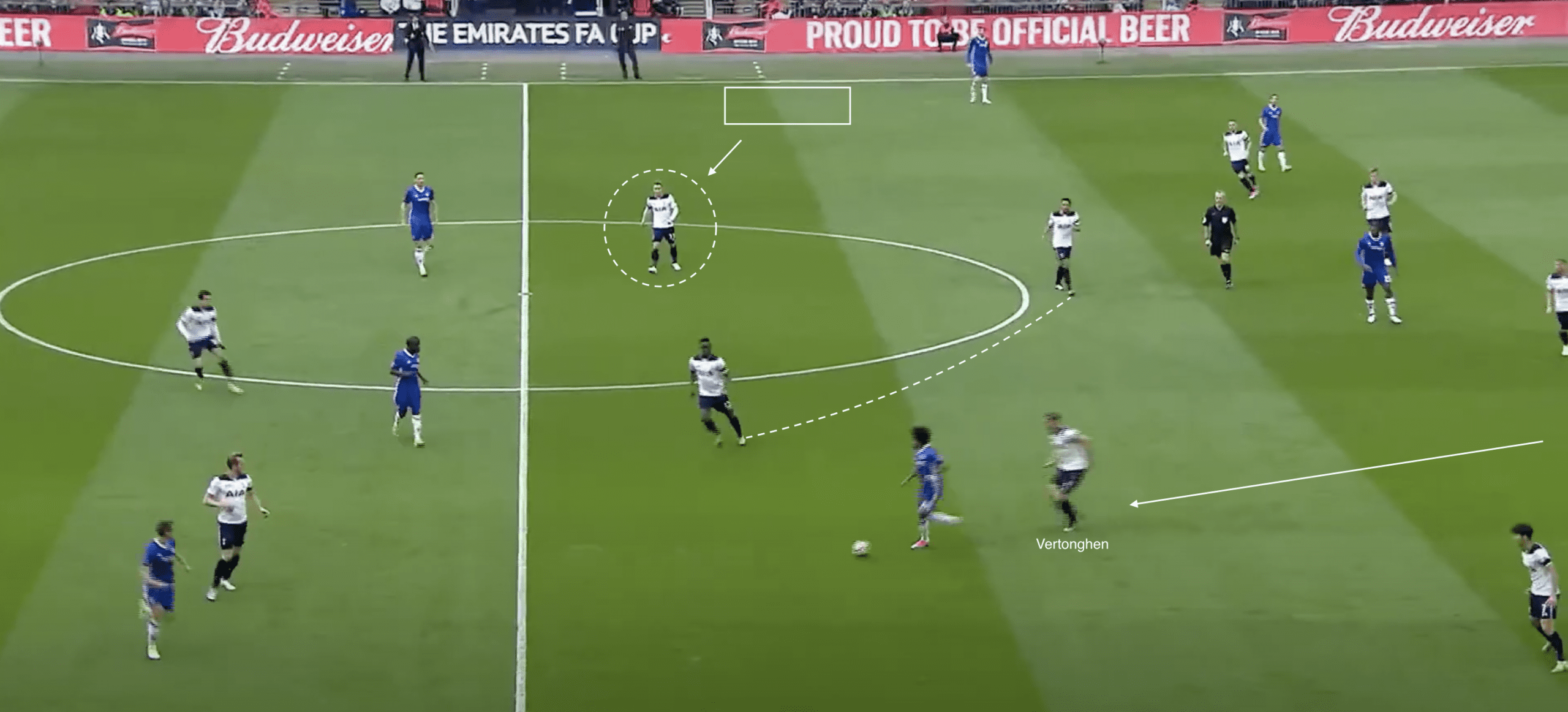
Jan Vertonghen found himself tracking Willian for much of the game, fortunately, Eric Dier and Toby Alderweireld shifted over to plug up any gaps left by the left-footed Belgian.
Another key aspect is the role of the attacking-midfielders, in this example, Christian Eriksen, as he drifts into the midfield to help limit Chelsea’s space in that area.
The Dane leaves the space on his right unoccupied with the hope that his right-back can recognise if a ball is being played into that space.
The 2016/17 campaign was the pinnacle of that high energy pressing from Tottenham Hotspur that everyone came to know and fear.
In their 2-0 triumph against Manchester City, Spurs opted for a more reserved press.
Rather than push all their men up the pitch and lose the backbone of their shape in the defence, Pochettino told his players to only press high in certain periods of time.
These periods of high-intensity pressing caught City off guard on numerous occasions.
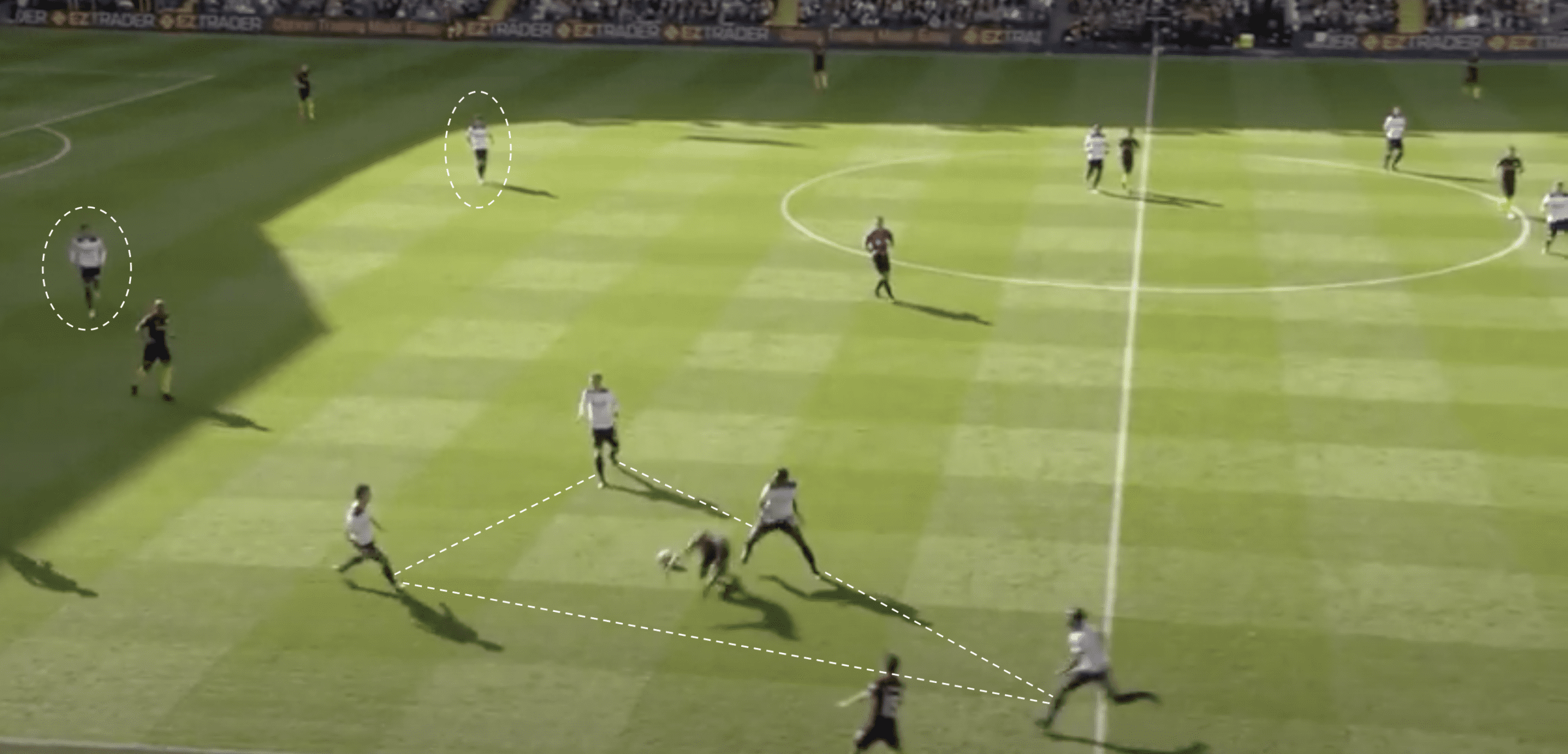
The team stayed connected and pressed as a unit, as seen in this example.
The two attacking midfielders along with the left-back and defensive midfielder work together to trap City in a corner and force a turnover.
Harry Kane and Dele stayed high and operated as outlets for a quick counter-attack.
Pochettino does not live or die off the press, but more often than not his team is better off with it.
The Argentinian’s flexibility in the press is what differentiates his pressing style from any other manager and has been a source of goals for most of his time at Spurs.
Mauricio Pochettino On the ball
Pochettino’s lack of a fixed shape was a major factor in Tottenham’s possession numbers during his five-year stay.
While for the majority of time, Pochettino went with a more standard 4-2-3-1, this shape could easily revert to the 3-4-2-1 that we mentioned before, and vice versa. Eric Dier was a key player in allowing Spurs the ability to be this flexible.
While often starting the match as one of two defensive midfielders, Dier usually ends up in a back three at some point to help in defence or just assist in playing out of the back.
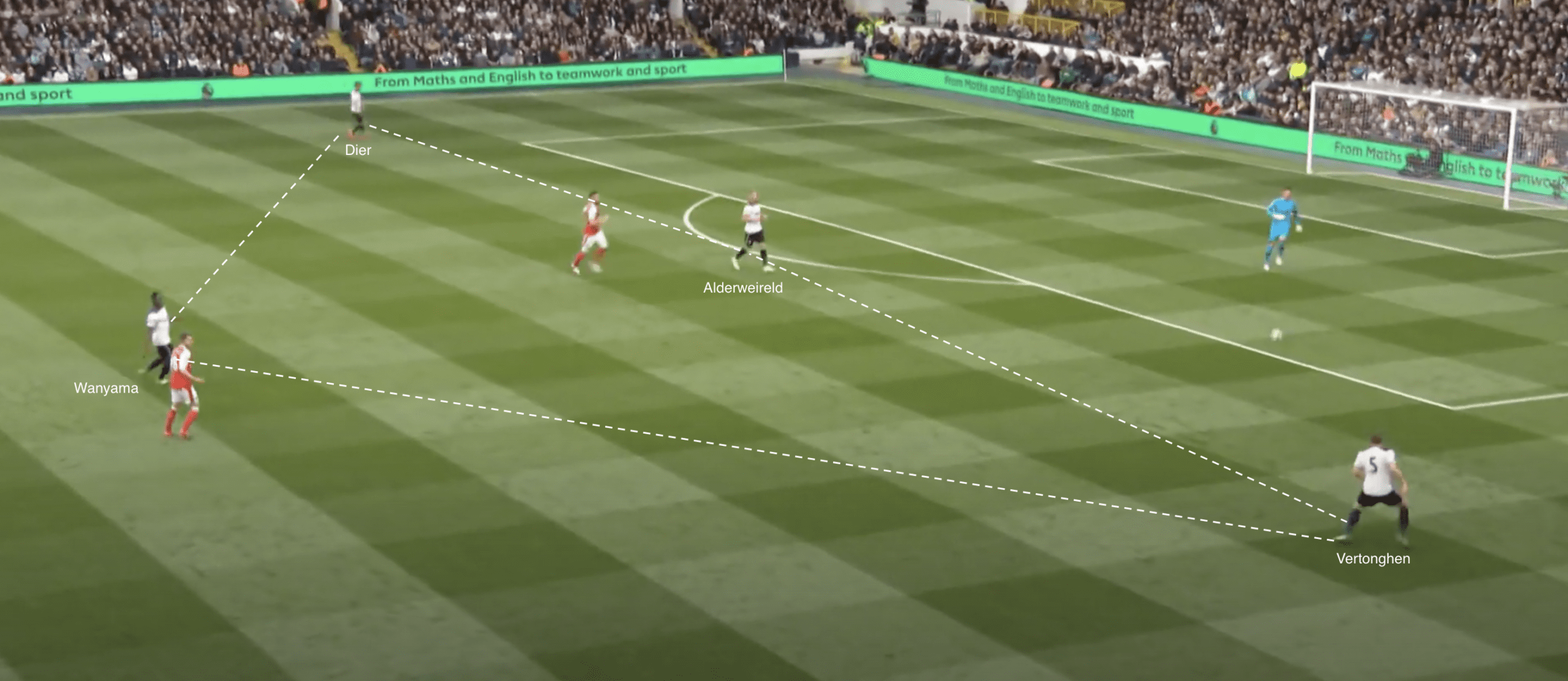
When Dier drops in as the right centre-back, this expands the pitch, opens up space in the midfield, and discourages any opposition press.
Wanyama sat on the top of the triangle but it was the centre-backs who really dictated play.
Moving higher up the pitch, Pochettino’s sides are all very fluid throughout their attacks.
Usually spearheaded by a creative 10, such as Christian Eriksen or Adam Lallana for Southampton, these players are essential in finding space between the lines and advancing the ball wide to the wing-backs, another vital piece of Pochettino’s system.
Of the 59 assists in all 2016/17 competitions for Spurs, 25.8% of those assists came from the four full-backs.
A prime example of Spurs in their narrow 4-2-3-1 shape came during a classic draw against City.
While initially narrow, ironically the source of attack ends up coming from one of the wide players.
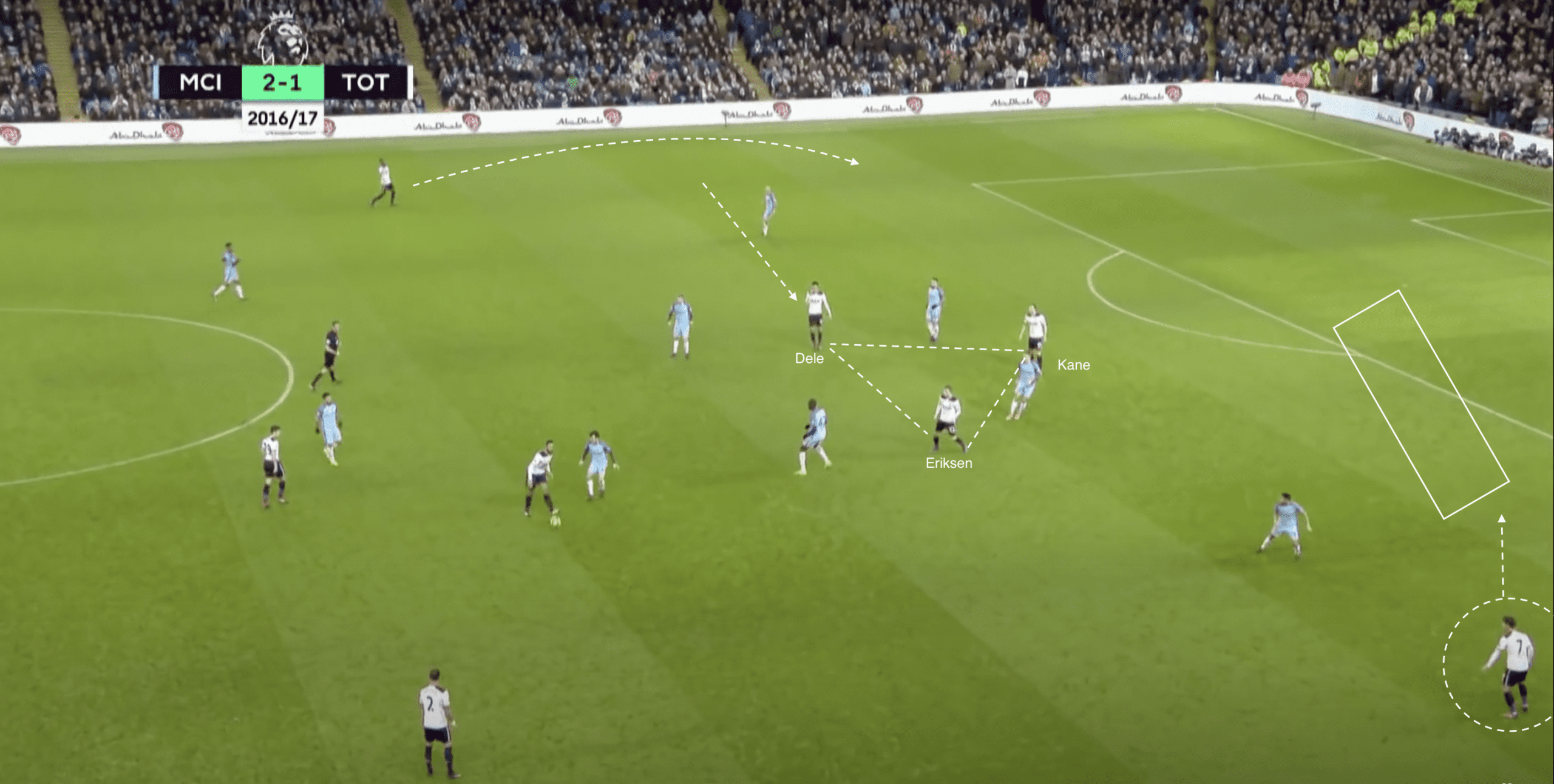
Dele shifts over into the middle from his left-wing position which opens up acres of space for Danny Rose at left-back.
Meanwhile, Kyle Walker holds his position at right-back to provide any defensive support for a potential Manchester City counterattack.
Kane, Eriksen, and Dele form a triangle that allows them to better combine and link-up.
This also further isolates their winger, Son Heung-min, who is now in a one on one situation with City’s left-back.
A similar example occurred the next season when Son was deployed on the left side, and the right-back was providing the only width on the right side.
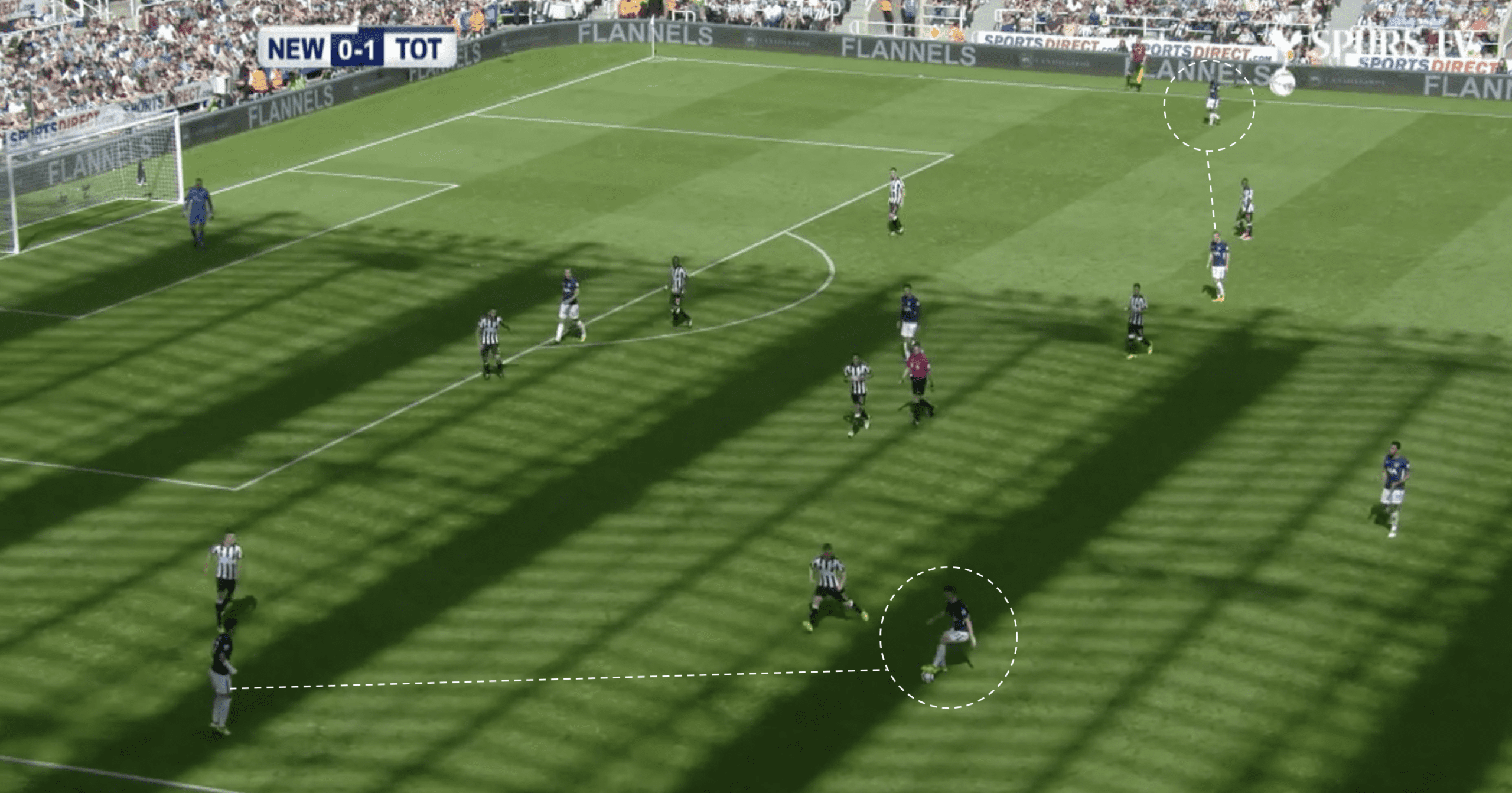
Kyle-Walker-Peters hugs the right flank, while Eriksen is still a pass away from the Englishman.
Son provides width for his left-back in Ben Davies, who is playing a role as a more traditional full-back.
Yet again, Pochettino can adapt and be flexible in his team’s shape.
This attacking triangle is also evident when Spurs are trying to progress the ball from defence.
In this case, Spurs are lined up in their 4-2-3-1 shape.
Nonetheless, the overall shape is very narrow and centre focused.
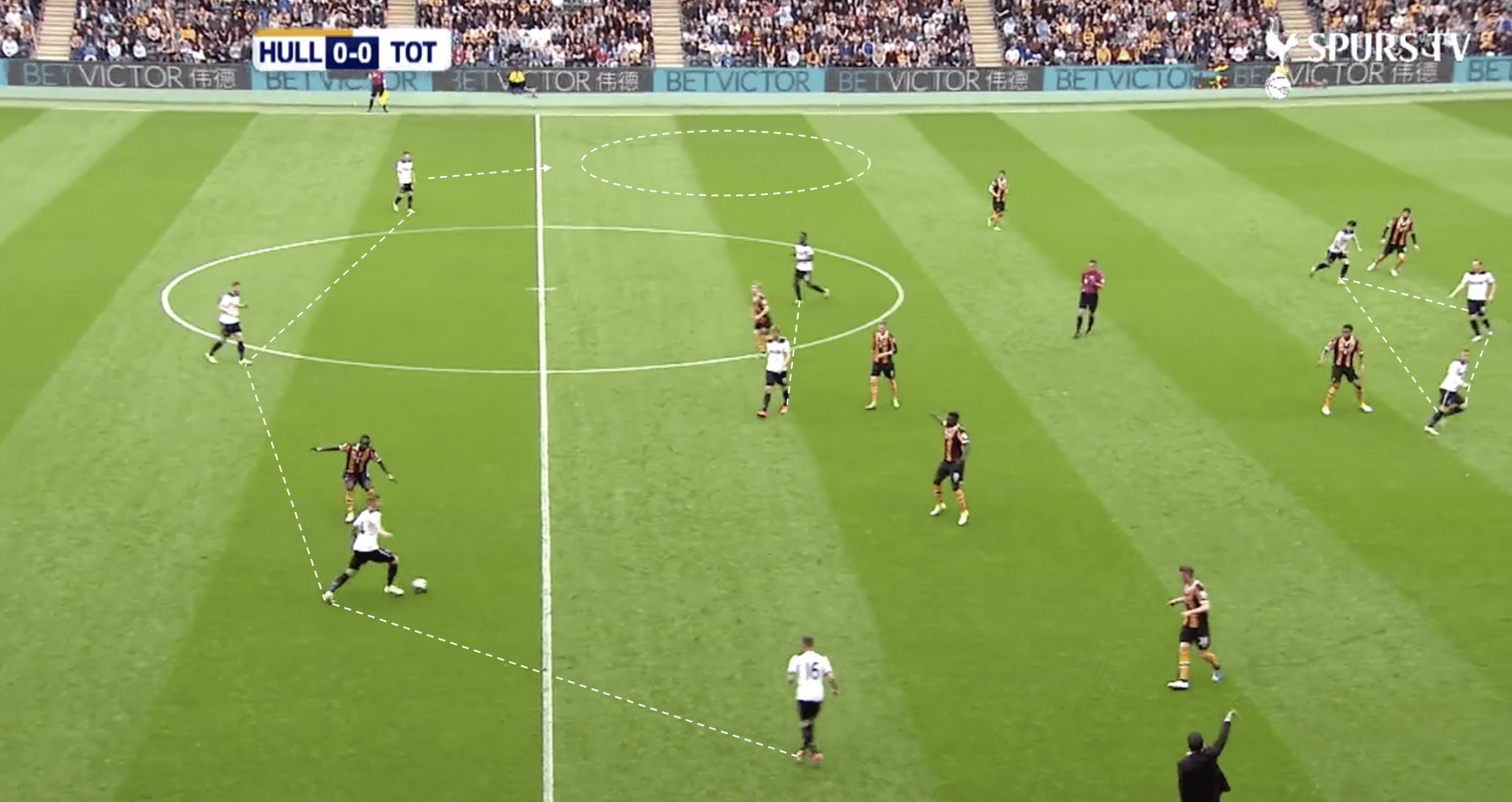
With the wing-backs tucked in and the two defensive-midfielders marked, the onus to progress the ball rests in the hands of Kane, Eriksen, and Son.
The three are almost interchangeable when they form their triangle and become a defence’s worst nightmare with their movement.
As mentioned a little earlier, wing-backs were and surely will continue to play a huge role in Pochettino’s system.
In Kyle Walker and Danny Rose, Pochettino had athletes who were happy to get up and down the pitch constantly.
In his latter days, this simply was not the case with an ageing Rose and less athletically gifted Kieran Trippier.
With two wing-backs in their prime, Spurs could slice through teams and find either Walker or Rose in space.
In the same match against City, Kyle Walker is the wing-back getting up the pitch.
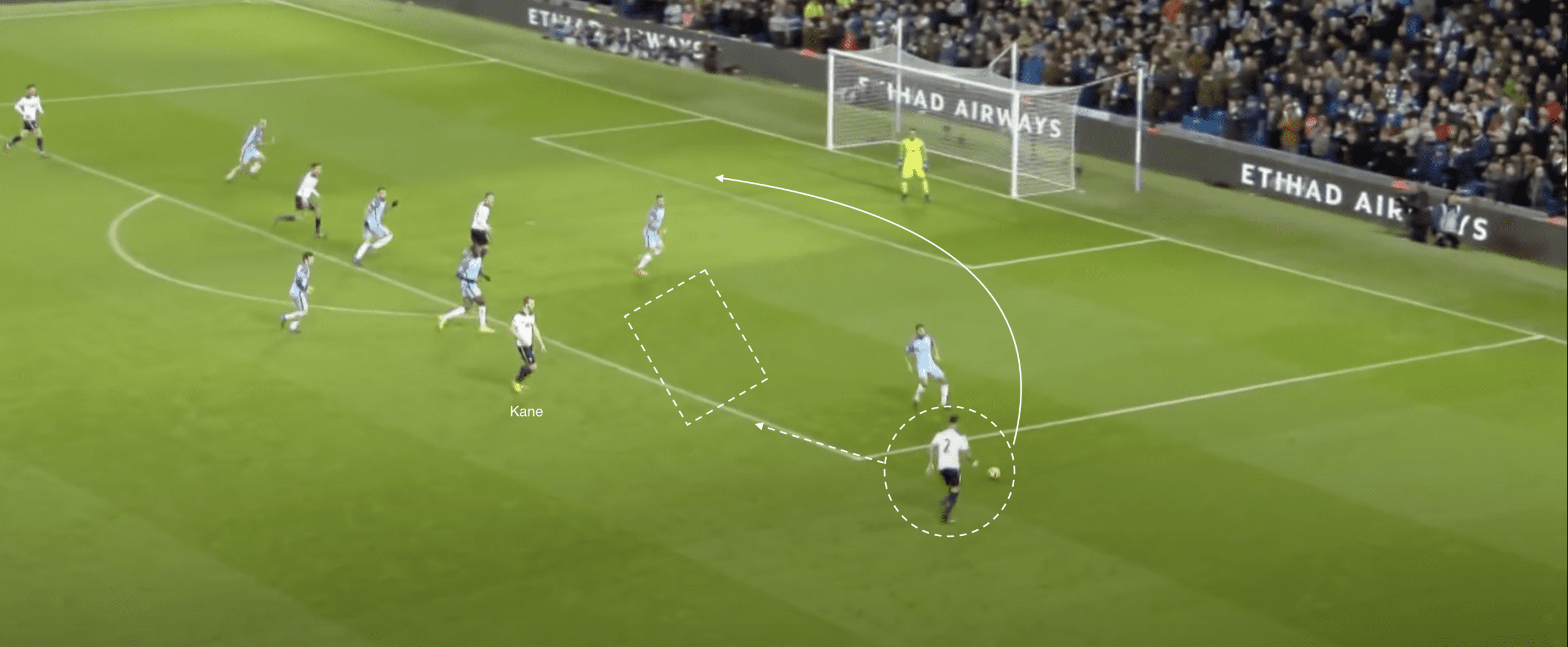
He uses his speed to get into a crossing position and Harry Kane opens up vital space in the middle by hanging back and presenting himself as an option.
What ensues is a brilliant run by Dele through the gut of the City defence and an equally impressive cross from Walker to grab a goal back for Spurs.
Tottenham’s buildup is narrow, but that’s all a ploy to suck a defence in and find the final ball through the wide-men.
Mauricio Pochettino Defensive shape
One of the mysterious cases of Tottenham Hotspur’s downfall under Pochettino was the rapid decline of their once unbreakable defence.
While there are many factors into why Spurs went from having a top-three defensive record for four seasons straight to conceding 10 goals to Bayern Munich and Brighton Hove Albion in a week, ultimately this is a result of how Pochettino set his team up.
In the 3-4-2-1 shape, Spurs could easily transition into a back five which essentially covered any possible space in behind the line.
The wing-backs in this example, tuck inside to link up with the three centre-backs while Wanyama, Dembélé, and Eriksen drop deeper to cover the midfield.
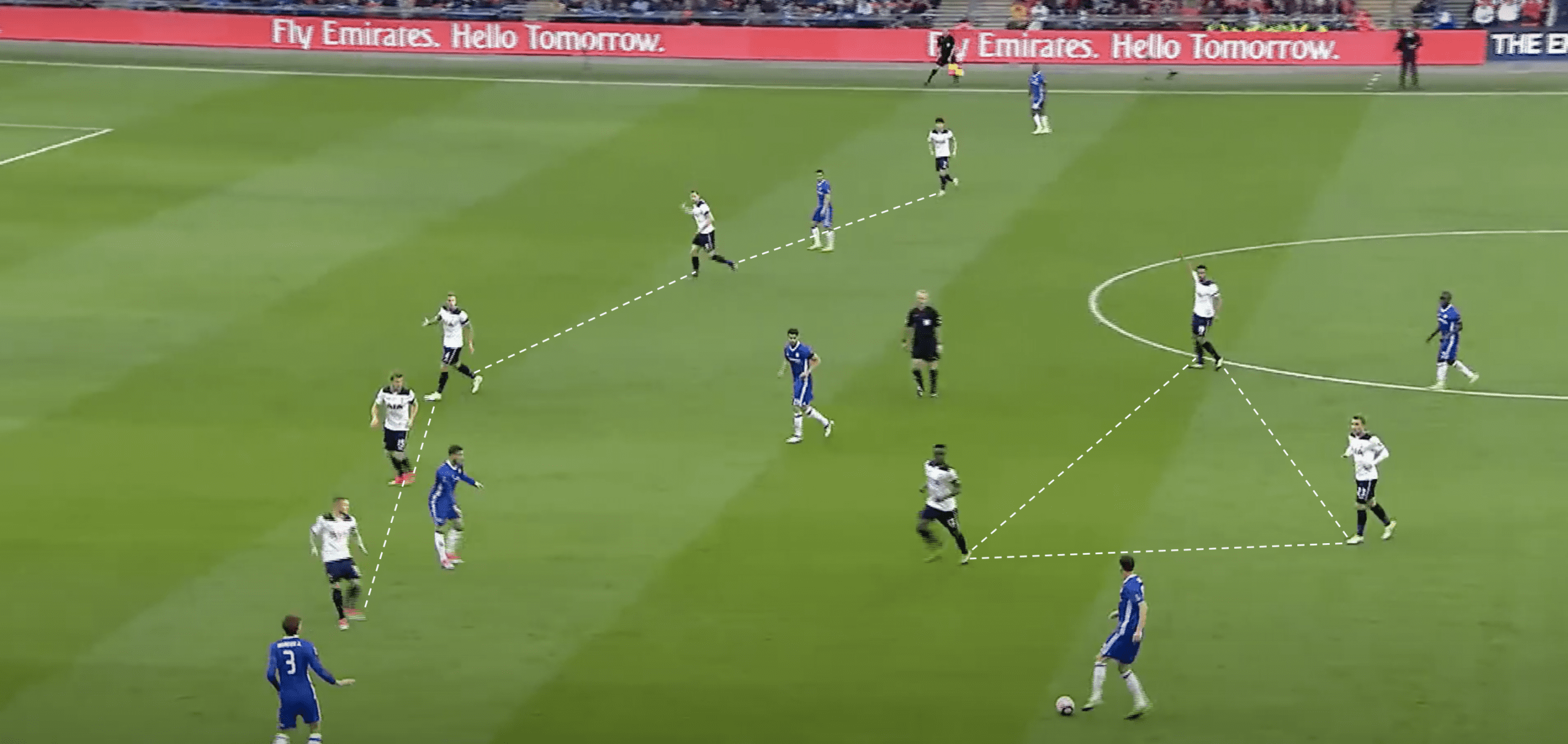
Against tougher teams, Mauricio Pochettino tends to favour a bit more conservative approach and this shape offers much more defensive cover than anything else.
Spurs were able to move their wing-backs up and initiate a press while also having the security of a back five if needed. Having the right personnel for this system is vital, and we’ve seen the effects of not having the necessary players in Pochettino’s last matches at the club.
One case of this came earlier this season.
In a match where they struggled to create, Tottenham were sliced open by a struggling Watford side with ease.
As they were increasingly frustrated by Watford’s resilience in defence, Spurs pushed more men up, which led a three-man defence largely exposed for most of the match.
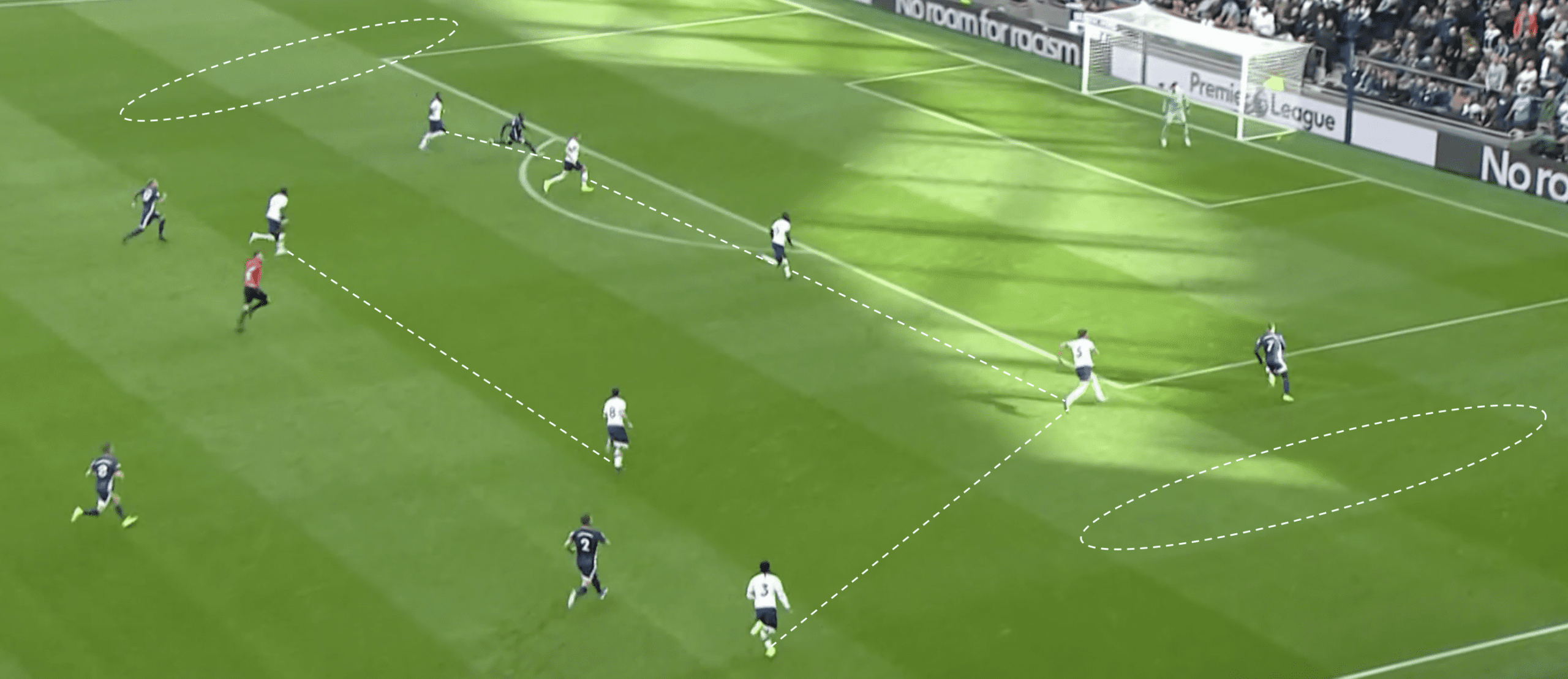
The wing-backs, Serge Aurier and Danny Rose, were caught out by Watford’s counter on numerous occasions and the midfield duo of Moussa Sissoko and Harry Winks lacked any real defensive conviction.
Thus, Spurs’ back-three were stretched on essentially every Watford move.
Again in this example, Tottenham’s shape is quickly in disarray when their attempted press is beaten by a long ball over the top.
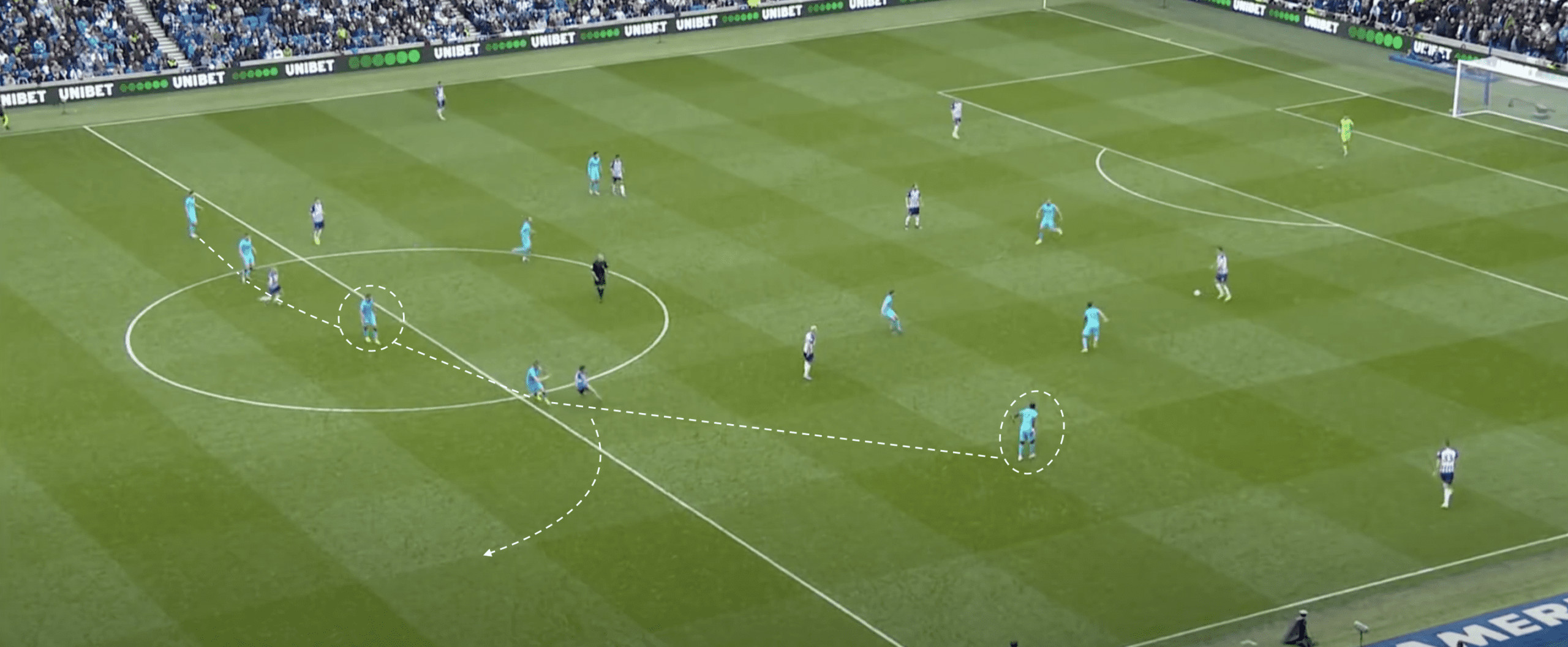
With Moussa Sissoko filling in at right-back and pulled out of position, it becomes a footrace between the Brighton attacker and Toby Alderweireld.
The backline is offered no support from an even weaker midfield of Christian Eriksen and Winks, two players who are much better with the ball at their feet.
Pochettino’s back three can work, but without organization, it can quickly become dismantled.
As we saw with the 2016/17 team, Spurs had two anchors in the middle with Wanyama and one of Eric Dier or Moussa Dembélé.
With the latest Tottenham squad, they lack any real defensive midfielder and have paid the price for that gap in personnel.
Conclusion
Mauricio Pochettino has become a forgotten man in fpremierootball, but just a year ago he was leading out Tottenham Hotspur in the biggest competition in Europe.
Mauricio Pochettino tactics and system were arguably ahead of his time, and with the right players, he could well break his unlucky streak of trophyless seasons.
He’s in no rush to jump into a job, but Mauricio Pochettino will make waves in whatever league he decides to challenge himself in.
Top-quality managers know how to adapt and win, Pochettino is one of them.






Comments